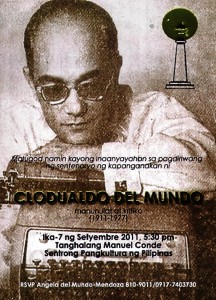
Last Sept. 7, writers, students and friends celebrated the birth centenary of Clodualdo del Mundo Sr. (1911-1977) at the Cultural Center of the Philippines.
National Artist Bienvenido Lumbera, Efren Abueg, Jose Ladera Santos and Hugo Yonzon III gave testimonials, cherishing years of working, collaborating, and reading Del Mundo’s works.
Abueg recalled his days in Liwayway magazine, how he learned from “Mang Danding,” as Del Mundo was fondly called then.
He remembered some of Del Mundo’s finest works like “Bignay” (The Wild Berry Tree) and the more popular works Abueg grew up with, such as the supernatural tales in “Kaharian sa Ilalim ng Lupa” (The Underworld Realm).
Del Mundo was, indeed, a scholar, and during the early days of Filipino modernism in literature, he became famous for his critical column, “Tao sa Parolang Ginto,” (The Man in the Golden Lighthouse), published in Taliba and Liwayway.
His critical articles and commentaries came out with monthly and annual recognition of the best literary works.
‘Mula sa Parolang Ginto’
Some of his articles were later compiled in a book, “Mula sa Parolang Ginto” (From the Golden Lighthouse).
In 1936, he co-edited with Alejandro G. Abadilla a book titled “Mga Kuwentong Ginto” (The Golden Stories), a compilation of the best short stories from 1925-1935.
Together with Mars Ravelo, Pablo S. Gomez and Francisco Coching, Del Mundo was considered one of the most prolific writers in the 1950s. Starting in 1947, Ace Publications’ Pilipino Komiks, Hiwaga, Espesyal and Tagalog Klasiks helped the Tagalog komiks into its golden years.
Del Mundo’s partnership with Fred Carrillo created some of the Philippines’ great komiks works, which include dramas such as “Malvarosa,” “Kadenang Putik,” “Kapitan Bagwis” and “Pitong Sagisag”; action stories such as “Ripleng de Rapido,” “Paltik” and “Asintado”; and science-fiction such as “Tuko sa Madre Kakaw” and “Zarex.”
Some of Del Mundo’s stories became the material for movies produced by LVN Pictures and Premiere Productions, including “Kadenang Putik” (1960).
Del Mundo also adapted Jose Rizal’s “Noli Me Tangere” into the komiks medium.
His most popular radio serial was “Prinsipe Amante,” which was aired from 1945 to 1953. The story was made into a blockbuster film by Lamberto V. Avellana in 1950. “Prinsipe Amante” (Prince Amante) and an excerpt of “Malvarosa” were performed during the celebration of Del Mundo’s centenary.
Friends and writers who treasure Del Mundo’s legacy and continue to propagate Filipino language will expect more events such as publications, contests and grants throughout Del Mundo’s centennial year, culminating in an exhibit in 2012.

